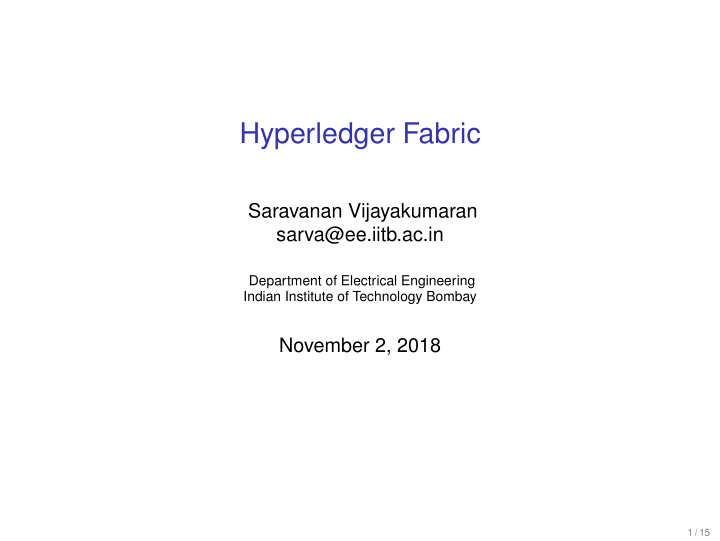



Hyperledger Fabric Saravanan Vijayakumaran sarva@ee.iitb.ac.in Department of Electrical Engineering Indian Institute of Technology Bombay November 2, 2018 1 / 15
Hyperledger • Collaborative blockchain effort hosted by Linux Foundation • Mission • Create enterprise grade, open source distributed ledger frameworks • Launched in 2016 with Fabric and Sawtooth • Currently 5 frameworks and 5 tools • Companies contribute code under Apache License • Does not require modifications to be distributed under the same license 2 / 15
Hyperledger Fabric • Permissioned distributed ledger framework with smart contracts • Originated in IBM in mid-2015 as Open Blockchain (OBC) project • Initial implementation completed in Dec 2015 • 40K lines of Go code, smart contracts, PBFT consensus • IBM joined Hyperledger in Feb 2016 and donated OBC code • Main features • Members of a Fabric network enroll through a Membership Service Provider • A group of participants can create a channel (shared ledger) • Copies of the channel ledger present only with channel participants • Each ledger contains world state and transaction log • Transactions are used to update state • Smart contracts (called chaincode) are written in Go • Client SDKs available in Node.js and Java • Querying ledger for transactions or blocks • Installing chaincode in peer nodes • Creating transactions calling chaincode functions • Pluggable consensus mechanism 3 / 15
Ledger Image credit: https://hyperledger-fabric.readthedocs.io/en/ release-1.3/ledger/ledger.html 4 / 15
World State Image credit: https://hyperledger-fabric.readthedocs.io/en/ release-1.3/ledger/ledger.html 5 / 15
Blockchain Image credit: https://hyperledger-fabric.readthedocs.io/en/ release-1.3/ledger/ledger.html 6 / 15
Blocks Image credit: https://hyperledger-fabric.readthedocs.io/en/ release-1.3/ledger/ledger.html 7 / 15
Peers Image credit: https://hyperledger-fabric.readthedocs.io/en/ release-1.3/peers/peers.html 8 / 15
Multiple Ledgers and Chaincodes Image credit: https://hyperledger-fabric.readthedocs.io/en/ release-1.3/peers/peers.html 9 / 15
Application-Peer Interaction Image credit: https://hyperledger-fabric.readthedocs.io/en/ release-1.3/peers/peers.html • Ledger queries involve only first three steps • Ledger updates involve all five steps • Application needs to send proposed updates to several peers 10 / 15
Channels Image credit: https://hyperledger-fabric.readthedocs.io/en/ release-1.3/peers/peers.html 11 / 15
Ledger Updates Phase 1: Proposal Image credit: https://hyperledger-fabric.readthedocs.io/en/ release-1.3/peers/peers.html • Application sends transaction proposal to some peers for endorsement • Peers execute the transaction and append signatures endorsing the proposal • Phase 1 ends when application receives sufficient responses 12 / 15
Ledger Updates Phase 2: Packaging Image credit: https://hyperledger-fabric.readthedocs.io/en/ release-1.3/peers/peers.html • Endorsed transaction proposals are packaged into a block by the orderer 13 / 15
Ledger Updates Phase 3: Validation Image credit: https://hyperledger-fabric.readthedocs.io/en/ release-1.3/peers/peers.html • Orderer distributes blocks to all peers • Each peer checks that a block satisfies the organizational endorsement policy and applies to ledger 14 / 15
References • Hyperledger https://eprint.iacr.org/2014/349.pdf • Apache License https://en.wikipedia.org/wiki/Apache_License • Fabric History https://www.linkedin.com/pulse/ hyperledger-fabric-brief-history-binh-nguyen/ • Fabric Architecture https://arxiv.org/abs/1801.10228v1 • Documentation https://hyperledger-fabric.readthedocs.io/ 15 / 15
Recommend
More recommend